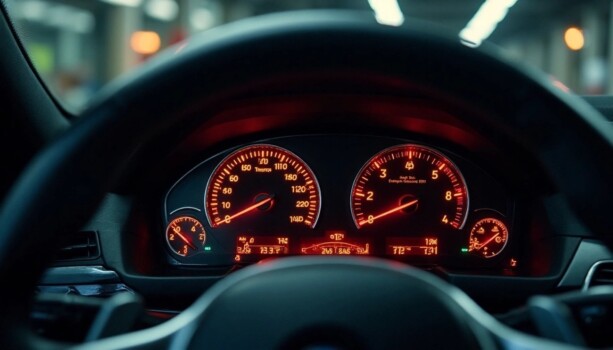That moment of panic hits you at the time a mysterious BMW fault light starts to light up your dashboard. Don’t worry – you’re not alone. BMW fault lights use a simple yet vital traffic light color system. Green signals tell you everything works fine. Yellow ones let you know something needs attention soon. Red warnings demand immediate action.
Your BMW’s performance and safety depend on your understanding of these warning lights. The yellow check engine light might point to anything from small electrical sensor problems to serious mechanical failures. Red warnings like brake system alerts or engine temperature indicators need your immediate attention. These warnings help you avoid dangerous driving conditions that can get pricey to fix. A yellow tire pressure light means your pressure dropped by 10%, while red warns you about rapid air loss.
Let’s break down the most common BMW fault lights in simple terms. We’ll cover everything from that puzzling triangle warning to specific BMW signs you should know. New BMW owners and experienced drivers alike will find this guide helpful. You’ll learn all about these essential dashboard indicators that keep you safe on the road.
Understanding BMW Warning Light Colors
BMW cars employ a smart color-coded system for dashboard warning lights. The system works like a traffic light, which helps drivers quickly understand how serious a problem might be.
Red lights: Stop immediately
Red BMW fault lights just need your immediate action. These critical warnings show serious problems that could damage your car or put your safety at risk. A red warning light means you should:
Stop driving as soon as you safely can Keep the car stopped until you fix the problem Call a BMW service center right away
Red lights usually point to critical problems with your brakes, an overheated engine, airbag system failures, or battery charging issues. The situation becomes more urgent if these warning lights flash instead of staying steady.
Yellow lights: Caution and check soon
Yellow BMW warning lights (sometimes called orange or amber) show problems that you should address soon but aren’t immediately dangerous. These warnings tell you something isn’t working right and you should get it checked, though your car remains safe to drive.
Common yellow fault lights include engine checks, low tire pressure warnings (about 10% pressure loss), service reminders, and Dynamic Stability Control alerts. Unlike red warnings, these give you time to book a service appointment without needing to stop right away.
Green and blue lights: Informational only
Green and blue lights serve as information signals rather than warnings. They show which systems are working normally or currently active. These indicators help you track your car’s regular operations.
Green lights show active features like turn signals, fog lights, Auto Hold system, or lane departure warnings. Blue lights typically let you know when your high beam headlights are on. These colors should reassure you rather than cause worry.
This color-coded system gives BMW drivers the basic knowledge to read dashboard signals correctly and take the right steps to keep their car safe and running well.
Red BMW Fault Lights You Should Never Ignore
Red BMW fault lights demand immediate attention, as they signal potentially dangerous issues that could lead to severe vehicle damage or safety risks. Whenever these critical warnings appear, pulling over safely and stopping your journey is the most sensible course of action.
Brake system warning
The brake system warning light (typically showing a circle with “!” or the word “BRAKE”) indicates your braking system may be compromised. This could signal dangerously low brake fluid levels, faulty braking force reinforcement, or a malfunctioning hill assist function. In the event that this light stays illuminated after releasing the parking brake, your braking system requires immediate professional attention. Never risk driving with this light on, as doing so could lead to complete brake failure, putting you and others in danger.
Engine overheating light
A red thermometer symbol indicates your engine is exceeding safe operating temperatures. Continuing to drive with an overheating engine can cause severe and irreparable damage. For this reason, if you notice this warning, pull over immediately and turn off your engine. Above all, resist the temptation to open the hood until the engine has cooled down. Engine overheating can warp cylinder heads and lead to a blown head gasket – one of the most expensive BMW repairs.
Airbag and seatbelt tensioner alert
This critical warning (shown as a seated passenger with a circle) indicates that your vehicle’s airbag system or seatbelt tensioners may be malfunctioning. Consequently, these vital safety features might not deploy correctly during an accident. The airbag system is designed to protect occupants during collisions, so any fault requires immediate professional diagnosis. This issue cannot be reset by disconnecting the battery and must be properly diagnosed and repaired.
Battery charging failure
The battery warning light (resembling a battery with + and – symbols) signals that your vehicle’s charging system isn’t functioning properly. Your car is running solely on battery power, which will eventually deplete. Accordingly, this could be caused by a faulty alternator, damaged wiring, corroded connections, or the battery itself. Without immediate attention, you risk complete electrical failure and being stranded.
Yellow BMW Warning Lights and What They Mean
Yellow lights on your BMW’s dashboard act as caution signals that show problems needing attention but don’t require you to stop right away. You can prevent serious issues by understanding these warnings early.
Check engine light
The check engine light looks like an engine outline and appears when your engine, emissions, or related parts have problems. Simple issues like a loose gas cap or serious engine malfunctions can trigger this light. A flashing light instead of a steady one shows a severe problem that needs immediate attention to save your catalytic converter. Bad spark plugs, sensor failures, and fuel system problems commonly cause this warning.
Tire pressure monitoring system
This warning shows a tire cross-section and lights up when your tires lose pressure. A yellow light shows about 10% pressure drop, while a red light means rapid air loss. Newer BMW models with iDrive tell you exactly which tire needs air. The Vehicle Status menu lets you reset this warning after fixing the pressure.
Steering system fault
The steering system warning looks like a steering wheel with an exclamation mark and shows power steering problems.
Your car becomes harder to steer with this fault, especially at low speeds. Low power steering fluid, failing pumps, or electrical issues in newer models with electric power steering usually cause this warning.
Dynamic Stability Control (DSC) issues
This light shows a car with skid marks and comes on when your traction control system has problems. DSC helps keep your car stable on slippery roads. The light flashes during active system engagement or stays on if it’s turned off or not working properly. A steady DSC light means you need professional help.
Diesel particulate filter warning
Diesel BMW owners see this filter-shaped warning when soot particles block their DPF. Cars driven on short, low-speed trips often face this problem because the filter can’t regenerate properly. Your car’s performance will suffer and might enter “limp mode” if you ignore this warning.
Green, Blue, and Other Informational BMW Signs
Green and blue BMW fault lights are different from their red and yellow counterparts. They don’t warn you about problems but let you know when systems are working normally and which features are turned on.
High beam and fog light indicators
Your dashboard shows different colored lights for various lighting functions:
Blue high beam indicator: Lights up when you turn on high beams
Green fog light symbol: Shows diagonal lines with a wave through them and a D-shaped headlight to show fog lights are on
Green low beam symbol: Appears when you’re using standard headlights
Green parking lights: Shows up when parking lights are on instead of main headlights
BMW’s High Beam Assistant can adjust your headlights automatically. The system shows a high-beam symbol with an “A” over the headlight image when it’s working.
Cruise control and Auto Hold
The Cruise Control light shows up as a road, car on a road, or speedometer with an arrow to confirm the system is running. Cars with Active Cruise Control display a car on a road with a small speedometer. This lets you set how far you want to stay behind other vehicles.
The Auto Hold feature shows “AUTO H” on your dashboard when it’s on. You won’t need to keep your foot on the brake pedal at stop lights because the system handles the brakes for you.
Lane departure and parking assist
A green car icon between two parallel lines shows up on your dashboard’s upper left when the Lane Departure Warning is working. Cameras watch the road lines and the system can shake your steering wheel or adjust your car’s position if you start to drift.
The Parking Assistant makes parallel parking easier. Just press the parking assistant (P) button and your BMW looks for spots big enough to park. The car steers while you control the speed.
Service reminder and fuel level alerts
Your BMW tells you when it needs maintenance through service reminders. The Fuel Level Alert works on its own, separate from the main fuel gage. It uses a different float system to tell you when you’re running really low on fuel.
Conclusion
BMW fault lights ended up being your first defense against potential vehicle problems. This piece decodes BMW’s traffic light-inspired warning system. Red lights just need immediate action, yellow lights signal caution, and green or blue indicators provide information about active systems.
Your ability to recognize these dashboard signals helps prevent repairs that can get pricey and keeps you safe on the road. You should never ignore red warnings about brake failures, engine overheating, or airbag malfunctions. Yellow cautions like check engine lights or tire pressure warnings give you time to schedule the work to be done.
BMW’s sophisticated warning light system might seem overwhelming initially. The color-coded approach makes vehicle maintenance simpler for drivers at every experience level. This knowledge helps you identify whether a dashboard light needs urgent professional attention or simply indicates a normal vehicle function.
Regular maintenance checks help prevent many warning lights from appearing. Your familiarity with these common indicators will strengthen your ability to respond appropriately when they appear. This ensures your BMW stays the ultimate driving machine for years ahead.
FAQs
Q1. What do the different colors of BMW warning lights indicate?
BMW warning lights follow a traffic light- inspired system. Red lights demand immediate action, yellow lights indicate caution and need attention soon, while green and blue lights are informational and indicate normal functioning systems.
Q2. What should I do if a red warning light appears on my BMW dashboard?
If a red warning light appears, you should stop driving as soon as it’s safely possible. Do not continue your journey until the issue is resolved, and contact a BMW service center immediately.
Q3. Can I continue driving if I see a yellow warning light on my BMW?
Yes, you can generally continue driving when you see a yellow warning light. However, it indicates an issue that needs attention soon. Schedule a service appointment to have the problem checked and resolved.
Q4. How can I read BMW fault codes?
To read BMW fault codes, locate the OBD2 port (usually under the dashboard near the driver’s seat), plug in an OBD2 reader, turn on the ignition without starting the engine, scan for codes, and then interpret them using a BMW code reference guide or professional assistance.
Q5. What does the check engine light on a BMW typically indicate?
The check engine light on a BMW can indicate various issues, ranging from minor problems like a loose gas cap to more serious engine malfunctions. Common causes include bad spark plugs, sensor failures, or fuel system problems. If the light is flashing, it indicates a severe problem requiring immediate attention.



